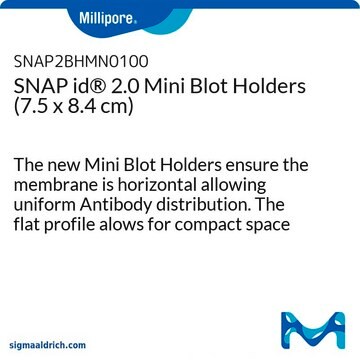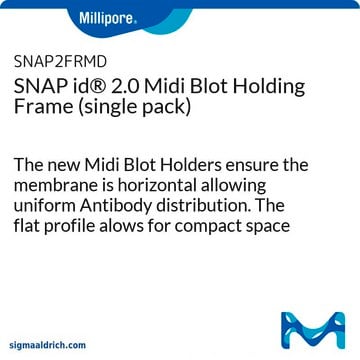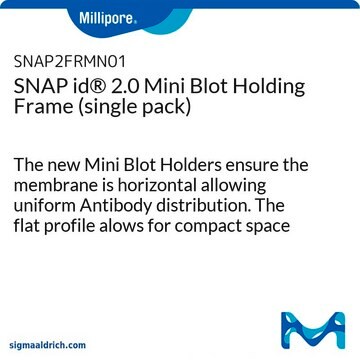SNAP2MB1
SNAP id® 2.0 Protein Detection System
Mini and MultiBlot
Synonim(y):
System wykrywania białek
About This Item
Polecane produkty
Nazwa produktu
SNAP i.d. 2.0 Protein Detection System-Mini and MultiBlot (7.5 x 8.4 cm and 4.5 x 8.4 cm), Developed to meet the needs of our Western blotting customers, the SNAP i.d. 2.0 system produces blots of a very high quality. Unique vacuum-driven technology & a built-in flow distributor actively drive reagents through the membrane.
producent / nazwa handlowa
SNAP id®
metody
western blot: suitable
kompatybilność
for use with Commercially available blocking reagents
for use with Luminata Western HRP Substrates
for use with Nitrocellulose
for use with PVDF (Immobilon membranes)
for use with blØk<TMSYMBOL></TMSYMBOL>-CH Buffer (cat. no. WBAVDCH01)
for use with blØk<TMSYMBOL></TMSYMBOL>-FL Buffer (cat. no. WBAVDFL01)
for use with blØk<TMSYMBOL></TMSYMBOL>-PO Buffer (cat. no. WBAVDP001)
for use with commercially available detection reagents
metoda wykrywania
chemiluminescent
colorimetric
fluorometric
Warunki transportu
ambient
temp. przechowywania
room temp
Powiązane kategorie
Opis ogólny
Zastosowanie
Powiązanie
Informacje prawne
Oświadczenie o zrzeczeniu się odpowiedzialności
Certyfikaty analizy (CoA)
Poszukaj Certyfikaty analizy (CoA), wpisując numer partii/serii produktów. Numery serii i partii można znaleźć na etykiecie produktu po słowach „seria” lub „partia”.
Masz już ten produkt?
Dokumenty związane z niedawno zakupionymi produktami zostały zamieszczone w Bibliotece dokumentów.
Klienci oglądali również te produkty
Produkty
The possible causes and potential remedies for challenges encountered as a result of blocking, washing, antibody incubation, and detection/exposure of Western blots
Możliwe przyczyny i potencjalne środki zaradcze w przypadku wyzwań napotkanych w wyniku blokowania, płukania, inkubacji przeciwciał i wykrywania/ekspozycji Western blot.
Protokoły
The SNAP i.d. 2.0 Protein Detection System is the second generation of the SNAP i.d. method for detecting immunoreactive proteins on Western blots.
Western blot protocol details protein transfer from gels to nitrocellulose, crucial for immunoblotting procedures in research.
Protokół Western blot szczegółowo opisuje przenoszenie białek z żeli na nitrocelulozę, co ma kluczowe znaczenie dla procedur immunoblottingu w badaniach naukowych.
Nasz zespół naukowców ma doświadczenie we wszystkich obszarach badań, w tym w naukach przyrodniczych, materiałoznawstwie, syntezie chemicznej, chromatografii, analityce i wielu innych dziedzinach.
Skontaktuj się z zespołem ds. pomocy technicznej












